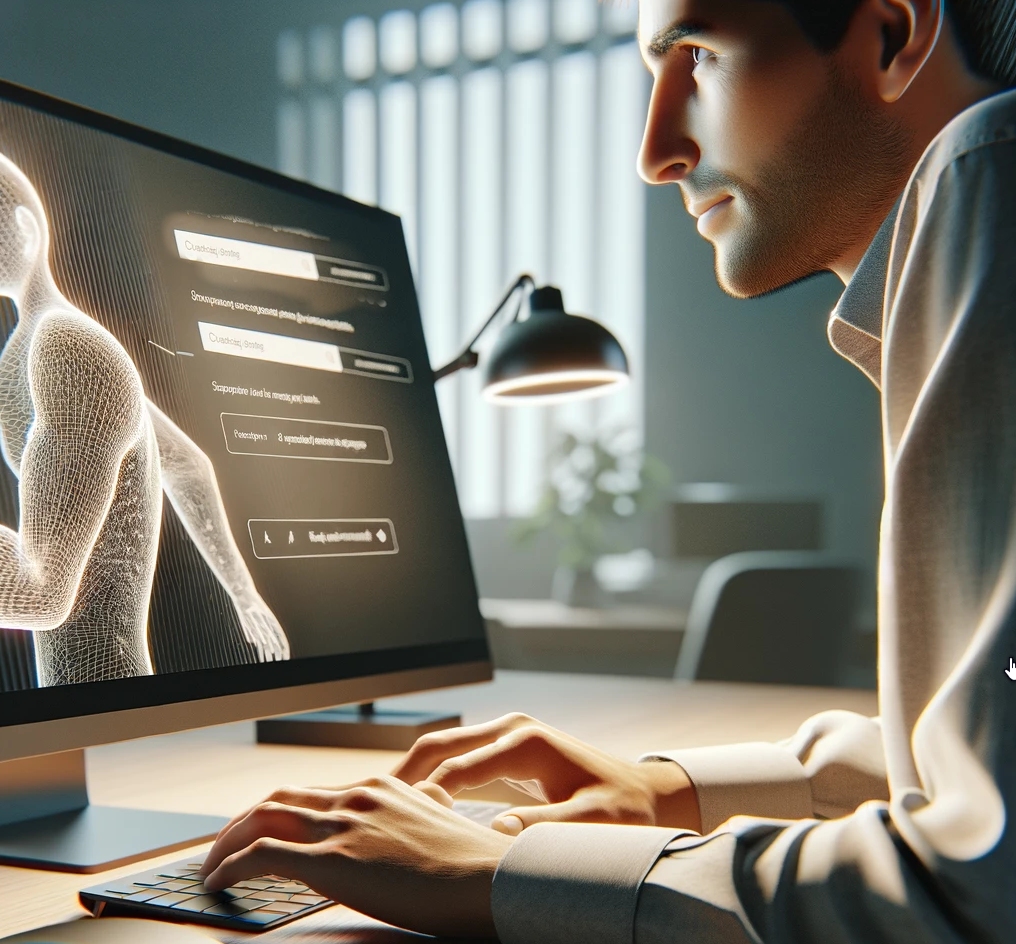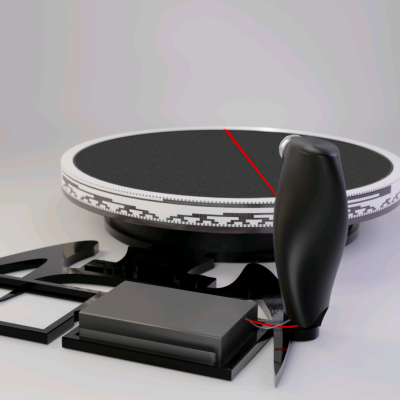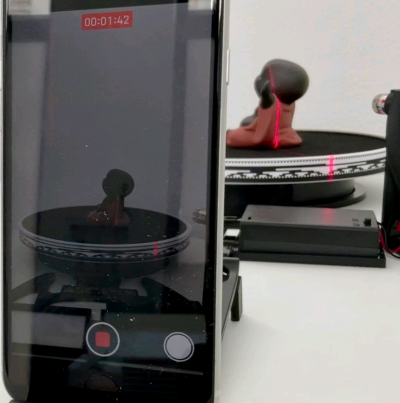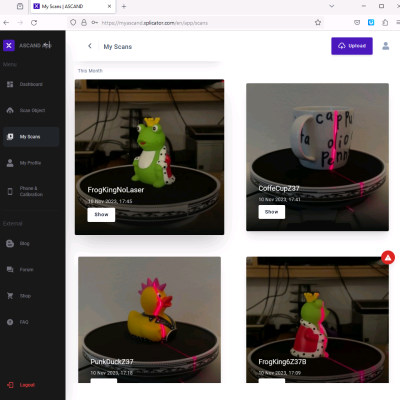
LEARN
All you need to know about the ASCAND 3D Scanning Platform
- ASCAND 3D Scanner Platform components
- How is the ASCAND 3D Scanning Platform different?
- VISION or LASER Scanning – Which one is right for you?
- Resolution Comparison Gallery
- Unboxing the ASCAND 3D-Capture:VISION Kit
- Creating the perfect VISION 3D Scan Video
- Unboxing the ASCAND 3D-Capture:Laser Expansion Kit
- Creating the perfect LASER 3D Scan Video
- Fine Tuning your Setup – Calibration
- Using the MACRO Kit to scan very small objects
- Unboxing the MAX30 Expansion Kit
ASCAND 3D Scanner Platform components

This is what you use to capture the 3D Scan Videos that are ASAND uses to create your 3D models. For VISION scans you just need the turn table with the Magic Sleeve. For LASER scans you also need the Scanner Body, a Laser Holder, a Laser and a Battery Holder – as shown in the image above.

You can use any recent ANDRIOD or iOS Phone to record and upload a 3D Scan Video for the ASCAND 3D Scanning Platform. For VISION Scans you only need to record a 75 second Video using your favourite Video App. For LASER scans you need to record a 150 second video with the Laser switched off for the last 75 seconds.

You can download your 3D models from your personal Dashboard on the ASCAND 3D Scanning Platform. You can even download a perfect Phone Holder for the phone model you register with your account. Plus there a lot of features that grow wiath every release.
How is the ASCAND 3D Scanner different?
Traditional 3D scanners are quickly outdated due to the limitations of the components they were originally designed for. They are also expensive to buy and fix because of the proprietary hardware components used.
This is especially bad if you want to get started on a budget getting your “feet wet”, then expand into something less “DIY”, and finally look into a professional solution delivering all the bells and whistles you can expect from the $1000++ investment traditional vendors require.
ASCAND’s capabilities grow with every phone upgrade, with every increase of cloud computing power, and with every upgrade we roll out.
Due to it’s unique architecture the model resolution can be freely set from 1mm to 0.1mm limited only by computing time and power.
The ASCAND Cloud keeps adding and combining bleeding edge Technologies instead of being stuck with what was initially chosen
ASCAND uses powerful Artificial Intelligence and Computer Vision algorithms that can be combined with Laser Triangulation and other technologies (like over sampling) running on a scalable server network in the Cloud. This grid is orders of magnitudes more powerful than the single-board computers squashed into traditional scanners or the chips that power even the most advanced phones.
To free you from having to waste your time or computing resources waiting for the results, you will receive an email with a link to download your 3D model once it is ready for use. The files are also added to your account dashboard where you can download the files or select further processing options.
VISION or LASER Scanning – Which one is right for you?
The ASCAND 3D-Scanning platform supports both vision and laser analysis of your scan videos. Understanding when to use each method can significantly enhance your scanning results.
Using the 3D-Capture:VISION without lasers is an easy way to start and is sufficient for most draft and standard use cases. This method is ideal for:
- Creating meshes for basic 3D printing
- Acquiring point clouds for 3D modeling software such as Blender, Meshlab, or others
- Generating LEGO build plans and Minecraft Schematic files
- Scanning in bright environments and day light
It delivers Point Clouds (PLY), 3D Printable Meshes (STL), and Color Meshes (OBJ) with resolutions down to 0.5mm using the Standard Table and resolutions down to 0.25mm using the freely downloadable MACRO kit.
The 3D-Capture:LASER Expansion Kit enhances the 3D Scan Toolbox by adding laser triangulation. It can be added to the VISION whenever it is needed. This method offers several advantages:
- Improves overall detail level in non-transparent and non-reflective objects
- Enables merging multiple scans into one, beneficial for scans that go beyond the object’s shell
- Provides better geometric accuracy
- Works better for models with cavities and holes
- Depending on the laser used, it is more sensitive to light and works in darker scan environments
It delivers Point Clouds (PLY), 3D Printable Meshes (STL), and Color Meshes (OBJ) with resolutions down to 0.19 mm using the Standard Table and resolutions down to 0.09 mm using the freely downloadable MACRO kit.
Unboxing the ASCAND 3D-Capture:VISION Kit
Watch a 2 minute quick unboxing video to learn how easy and fast it is to set up the ASCAND VISION Kit.
Creating perfect VISION 3D Scan Videos
Watch a 3 minute quick tuturial telling everything you need to know about creating these perfect 3D VISION scan videos that put high quality 3D models into your ASCAND dashboard. Without a laser and only relying on Computer Vision and AI.
Unboxing the ASCAND 3D-Capture: Laser Expansion Kit
Discover the next level of precision in 3D scanning with the ASCAND Laser Expansion Kit! Watch as we unbox this must-have upgrade for your ASCAND 3D-Capture system.
Creating perfect LASER 3D Scan Videos
Watch a 3 minute quick tuturial telling everything you need to know about creating these perfect 3D LASER scan videos that put high quality 3D models into your ASCAND dashboard.
Calibrating your 3D Scan Capture Setup
Your ASCAND 3D Capture Kit is pre-calibrated for a standard phone setup, but doing a personal calibration can give you that extra edge in performance tailored to your unique setup. Here’s how.
Using the MACRO Kit to 3D Scan Very Small Objects
The MACRO Table boosts the resolution of your 3D models. It comes with a smaller version of the Magic Sleeve and its ring. The best part? All its 3D printable components are available for free download on our website.
Unboxing the ASCAND MAX30 Expansion Kit
The MAX30 expansion features a larger 300mm turntable, enabling you to scan bigger objects with ease and efficiency, perfect for makers, educators, and professionals looking to expand their 3D scanning capabilities.
Resolution Comparison Gallery
There is nothing like the real thing. If you want to see real world ASCAND 3D scans, visit our Gallery Page.